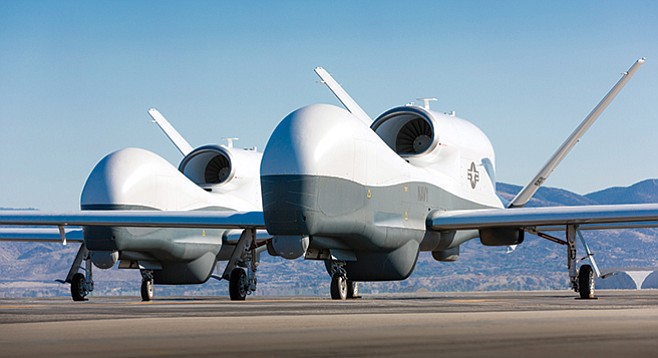 Facebook
Facebook
 X
X
 Instagram
Instagram
 TikTok
TikTok
 Youtube
Youtube

No wonder San Diego is called a Navy town. Federal military spending in San Diego on uniformed and civilian payrolls, along with veterans, is almost entirely related to the Navy, and half of military contract spending is for the Navy.
Beginning in 2012, military spending declined in San Diego. However, this year and next, San Diego’s total output of goods and services should rebound sturdily, thanks mainly to an increase in military spending, which could exceed 22 percent of the total local economy, or gross regional product.

During the years of contract and personnel decline, the San Diego economy swooned, too. According to San Diego economist Kelly Cunningham, the county’s total output of goods and services grew only 0.4 percent in 2015, a mere 0.3 percent in 2016, and an anemic 0.2 percent last year. Through those years, Cunningham heaped much of the blame on the decline in defense spending, accounting for about one-fifth of the total economy.
Kaboom! With President Trump pounding the drums for a stronger military, United States defense spending in this budget year will be $700 billion, a record, and more than the military outlays of Russia and China combined. The Pentagon will get a 15.5 percent leap in spending — a $94 billion increase. The president signed an omnibus bill that included the big military spending bump last month. In the 2019 budget year, federal defense spending should rise to $716 billion.
Expecting a more generous defense budget, Cunningham had predicted San Diego’s economic growth would rise 1.8 percent this year. Now he thinks it will go over 2 percent, maybe significantly above that. If the 2019 budget is truly $716 billion, the San Diego economic output should rise again, unless the overall economy goes into a tailspin, and that does not appear to be on the horizon now.
In February, Propel San Diego, a group that keeps tabs on military spending, released a report on 2017 defense contract spending in San Diego, showing that last year’s activity of $9 billion was up from $8.5 billion in 2016. This made San Diego the nation’s second-largest county in terms of military spending. Fairfax, Virginia, was in first place and Los Angeles County in fourth.
But last year’s $9 billion was down from $11.5 billion in 2012. Skeptics had wondered if San Diego would lose its Navy town title. Last year’s gain from $8.5 billion was a good step forward.
The Propel 2017 study showed General Atomics in the lead with $2.6 billion in contracts last year, up from $1.78 billion in 2016. Northrop Grumman was second with $1.56 billion last year, and General Dynamics’ NASSCO (National Steel and Shipbuilding Company) was third at $1.04 billion. Aircraft and shipbuilding will be major beneficiaries of the new, higher budget. General Atomics and Northrop Grumman are the leaders in the booming unmanned aircraft field, and NASSCO is huge in shipbuilding. NASSCO says it will hire up to 1000 workers to help it build Navy and other vessels.
Propel’s study predicted that employment in military contracting will rise 9 percent this year. Cunningham says that spending in dollar terms will go up at least that much.
All told, local military spending was $25.2 billion last year, according to the Propel study. Cunningham forecasts that military payrolls, including both uniformed and civilian personnel, will rise from $10.5 billion last year to $11.2 billion this year. About 22,000 San Diegans are on military payrolls now, and that will rise. Payments to veterans will rise from last year’s $4.9 billion to $5.1 billion this year.
More on-duty personnel will move to San Diego, predicts Cunningham, and that will put upward pressure on the median housing price. It’s already $575,100, fourth highest among major American metro areas. (San Jose is first at a staggering $1.25 million, followed by San Francisco at $928,600, according to Zillow.) “The number of military housed here had been in decline, but now there will be an increase, and we have to deal with it,” says Cunningham. The number of building permits declined last year. The supply/demand squeeze is painful. The onrush of military transfers will exacerbate that squeeze, “but the housing allowance for military personnel has increased quite a bit,” moderating the crush.

Lynn Reaser, who teaches economics at Point Loma Nazarene University and compiles data for Propel, says, “The new budget should help carry forward the Navy’s plan for expanding the number of ships homeported in San Diego in support of the Pacific Rim. Also, there is likely to be a significant impact in the shipbuilding and repair industry. Drone [unmanned aerial vehicle] manufacturing should get a boost, along with cyberwarfare contracts.” Military infrastructure should also rise with the bigger budget, she says.
The 20 percent–plus of the San Diego economy related to the military “should rise,” she says.
The percentage that the military contributes to some metro areas’ economies exceeds San Diego’s. For example, the Colorado Springs metro area, with five military commands including the Army’s Fort Carson and the Air Force Academy, gets 40 percent of its economic oomph from defense. The Hampton Roads, Virginia, metro area, where 64 ships homeport, is around 45 percent and has been at 50 percent. “San Diego used to be at 40 percent,” says Cunningham, but that was too high a number. The area would boom in wartime, “but when peace broke out, the economy would go into reverse.” The result was a boom-bust pattern that was not healthy. Now San Diego can rely on tech and biotech, tourism, trade, health care, universities, and other high employment sectors, as well as the military.
When the $700 billion Pentagon budget was finalized last month, skeptics worried that what the local economy gained in military spending it could lose in science spending. For example, cynics expected that the budget for the National Institutes of Health — particularly critical for the University of California at San Diego — would be slashed. It didn’t happen. That budget was boosted $3 billion to $37 billion.


No wonder San Diego is called a Navy town. Federal military spending in San Diego on uniformed and civilian payrolls, along with veterans, is almost entirely related to the Navy, and half of military contract spending is for the Navy.
Beginning in 2012, military spending declined in San Diego. However, this year and next, San Diego’s total output of goods and services should rebound sturdily, thanks mainly to an increase in military spending, which could exceed 22 percent of the total local economy, or gross regional product.

During the years of contract and personnel decline, the San Diego economy swooned, too. According to San Diego economist Kelly Cunningham, the county’s total output of goods and services grew only 0.4 percent in 2015, a mere 0.3 percent in 2016, and an anemic 0.2 percent last year. Through those years, Cunningham heaped much of the blame on the decline in defense spending, accounting for about one-fifth of the total economy.
Kaboom! With President Trump pounding the drums for a stronger military, United States defense spending in this budget year will be $700 billion, a record, and more than the military outlays of Russia and China combined. The Pentagon will get a 15.5 percent leap in spending — a $94 billion increase. The president signed an omnibus bill that included the big military spending bump last month. In the 2019 budget year, federal defense spending should rise to $716 billion.
Expecting a more generous defense budget, Cunningham had predicted San Diego’s economic growth would rise 1.8 percent this year. Now he thinks it will go over 2 percent, maybe significantly above that. If the 2019 budget is truly $716 billion, the San Diego economic output should rise again, unless the overall economy goes into a tailspin, and that does not appear to be on the horizon now.
In February, Propel San Diego, a group that keeps tabs on military spending, released a report on 2017 defense contract spending in San Diego, showing that last year’s activity of $9 billion was up from $8.5 billion in 2016. This made San Diego the nation’s second-largest county in terms of military spending. Fairfax, Virginia, was in first place and Los Angeles County in fourth.
But last year’s $9 billion was down from $11.5 billion in 2012. Skeptics had wondered if San Diego would lose its Navy town title. Last year’s gain from $8.5 billion was a good step forward.
The Propel 2017 study showed General Atomics in the lead with $2.6 billion in contracts last year, up from $1.78 billion in 2016. Northrop Grumman was second with $1.56 billion last year, and General Dynamics’ NASSCO (National Steel and Shipbuilding Company) was third at $1.04 billion. Aircraft and shipbuilding will be major beneficiaries of the new, higher budget. General Atomics and Northrop Grumman are the leaders in the booming unmanned aircraft field, and NASSCO is huge in shipbuilding. NASSCO says it will hire up to 1000 workers to help it build Navy and other vessels.
Propel’s study predicted that employment in military contracting will rise 9 percent this year. Cunningham says that spending in dollar terms will go up at least that much.
All told, local military spending was $25.2 billion last year, according to the Propel study. Cunningham forecasts that military payrolls, including both uniformed and civilian personnel, will rise from $10.5 billion last year to $11.2 billion this year. About 22,000 San Diegans are on military payrolls now, and that will rise. Payments to veterans will rise from last year’s $4.9 billion to $5.1 billion this year.
More on-duty personnel will move to San Diego, predicts Cunningham, and that will put upward pressure on the median housing price. It’s already $575,100, fourth highest among major American metro areas. (San Jose is first at a staggering $1.25 million, followed by San Francisco at $928,600, according to Zillow.) “The number of military housed here had been in decline, but now there will be an increase, and we have to deal with it,” says Cunningham. The number of building permits declined last year. The supply/demand squeeze is painful. The onrush of military transfers will exacerbate that squeeze, “but the housing allowance for military personnel has increased quite a bit,” moderating the crush.

Lynn Reaser, who teaches economics at Point Loma Nazarene University and compiles data for Propel, says, “The new budget should help carry forward the Navy’s plan for expanding the number of ships homeported in San Diego in support of the Pacific Rim. Also, there is likely to be a significant impact in the shipbuilding and repair industry. Drone [unmanned aerial vehicle] manufacturing should get a boost, along with cyberwarfare contracts.” Military infrastructure should also rise with the bigger budget, she says.
The 20 percent–plus of the San Diego economy related to the military “should rise,” she says.
The percentage that the military contributes to some metro areas’ economies exceeds San Diego’s. For example, the Colorado Springs metro area, with five military commands including the Army’s Fort Carson and the Air Force Academy, gets 40 percent of its economic oomph from defense. The Hampton Roads, Virginia, metro area, where 64 ships homeport, is around 45 percent and has been at 50 percent. “San Diego used to be at 40 percent,” says Cunningham, but that was too high a number. The area would boom in wartime, “but when peace broke out, the economy would go into reverse.” The result was a boom-bust pattern that was not healthy. Now San Diego can rely on tech and biotech, tourism, trade, health care, universities, and other high employment sectors, as well as the military.
When the $700 billion Pentagon budget was finalized last month, skeptics worried that what the local economy gained in military spending it could lose in science spending. For example, cynics expected that the budget for the National Institutes of Health — particularly critical for the University of California at San Diego — would be slashed. It didn’t happen. That budget was boosted $3 billion to $37 billion.
Comments